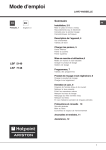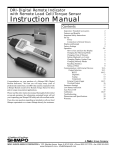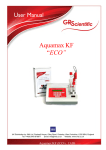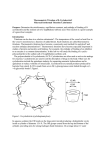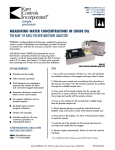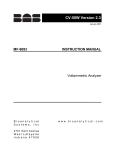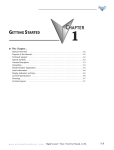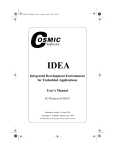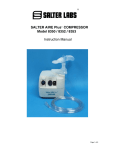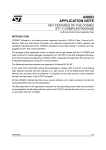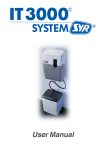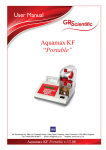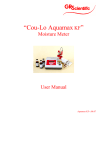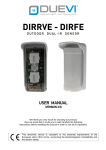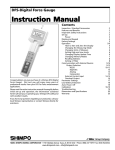Download KAM® KF KARL FISCHER MOISTURE ANALYZER
Transcript
KAM® KF KARL FISCHER MOISTURE ANALYZER USER MANUAL PER ISO 12937, ASTM D 4928, API MPMS 10.9, ISO 12937, IP 386 REV. 0112 KAM CONTROLS, INC. 3939 Ann Arbor Drive Houston, Texas USA 77063 T: +1 713 784 0000 F: +1 713 784 0001 www.KAM.com KAM CONTROLS is an ISO 9001 certified company. KAM CONTROLS, INC. reserves the right to make changes to this document without notice. TABLE OF CONTENTS SECTIONTITLEPAGE 1 Introduction 2 •Available models 2 •Theory of operation 2 2 Specifications 3 3 Components 4 • Display panel 4 • Titration Cell assembly 6 • Side and Rear Panels 7 4 Operation 8 • Assembly 8 • Adding Reagent 9 • Blank elimination operation 9 • Moisture content determination 10 • Sample dilution 11 5 Maintenance 12 • Reagent replacement procedure 12 • Storage 13 • Special Grease 13 • Electrode cleaning procedures 13 6 Ordering information 15 KFMANUAL 0112 1 KAM CONTROLS, INC. INTRODUCTION AVAILABLE MODELS and ACCESSORIES KAM® LKF Karl Fischer Moisture Analyzer Lab Model KAM® PKF Karl Fischer Moisture Analyzer Portable Model KAM® Homogenizer (For a full list of consumables, accessories, and parts, see page 15) THEORY OF OPERATION KAM Moisture Analyzers incorporate the coulometry principle applied to Karl Fischer titration to totally eliminate the troublesome procedures involved in conventional water determinations. Available in a lab model as well as a portable, KAM Moisture Analyzers are easy to use and fully automatic. The Portable Model has a rugged case for field water determinations and the capability to operate continuously for 10 hours before needing recharging. Incorporating a special electrolysis current control system, Moisture Analyzers assure fast, accurate measurement of even trace content. KAM Moisture Analyzers can be used to rapidly and accurately determine the water content of liquid hydrocarbons for all custody transfer operations: pipeline, marine, or truck movement. The Moisture Analyzer can also be used to analyze crude oils, distillates, transformer oils, jet fuels, chemicals, and most other liquids. In the plant, it can monitor the moisture content of streams during start-ups, shutdowns, upsets, and normal operations. This can be especially important on units where expensive catalysts can be damaged by excessive moisture. The unit also can be used by machinists as part of a preventive maintenance program. By analyzing lube oil on compressors, turbines, etc., the Moisture Analyzer can detect cooling water leaks before they become severe enough to damage equipment. Karl Fischer titrimetry is an accurate moisture measurement method utilizing the quantitative reaction of water with iodine. This method is the standard method of moisture measurement because of its speed and high sensitivity. In coulometric Karl Fischer titration, the sample is added to the Karl Fischer Reagent (iodine ion and sulfur dioxide as principal components). Iodine, generated electrolytically at the anode, reacts with water in the sample as shown in Formula 1. Iodine is generated in direct proportion to the quantity of electricity according to Faraday’s Law. Formula 1: I2 + SO2 + H2O - 2HI + SO3 One mole of iodine reacts quantitatively to one mole of water; therefore, 1mg of water is equivalent to 10.71 coulombs (Formula 2). Based on this principle, water content can be directly determined from the quantity of electricity required for electrolysis. This eliminates the need for addition of Reagent and tedious standardization procedures. Formula 2: 2I- - 2e- -I KFMANUAL 0112 2 KAM CONTROLS, INC. SPECIFICATIONS SPECIFICATIONS Method: Coulometric Karl Fischer titration, ASTM D 4928, API MPMS 10.9, ISO 12937, IP 386 Detection: Polarization detection Control: Automatic electrolysis current control Sample Size: 0.1, 0.25, 0.5, 1.0 ml for direct reading of volume % H2O, or less than two grams (ml) Range: 10 µg - 100,000 µg H2O (i.e. for a 100 µl sample, the direct display is 0.0010% to 10% H2O) Sensitivity: 1 µg H2O Precision: ±5 µg for 10 µg – 1000 µg 0.5% (C.V.) for over 1000 µg (meets or exceeds API MPMS 10.9, ASTM D 4928, and IP 386) Titration Speed: 1000 µg H2O/min. (max., at high H2O concentrations) Power Requirements: Operates on either AC or DC. AC - 110/120, 220/240 V, 50/60Hz DC - Rechargeable battery for portable model (12 - 14 V) Dimensions: Approx. 15 (W) x 10 (L) x 9 (H) inches Weight: Lab Model Approx. 10 pounds Portable Model Approx. 20 pounds KFMANUAL 0112 3 KAM CONTROLS, INC. COMPONENTS DISPLAY PANEL C. ON (Titration) The ON key has two functions: 1) It initiates the flow or titration current which corresponds to the moisture content in the sample. The titration current flows until all of the moisture is consumed (titrated). 2) The ON key also functions as the magnetic stirrer start switch. A. Microgram Mode Press to initialize measurement of the mass of water (in micrograms) in the injected sample. The numerical display will show the micrograms of water in the sample from 0 to 99,999. Note: Between titrations there will be some current flow to balance accumulated moisture. B. Volume Percentage Mode Press once to initialize measurement of the volume percentage of water in the injected sample. Press repeatedly to cycle through sample sizes to be injected (percent mode 0.1, 0.25, 0.5, or 1.0 ml; dilution mode 0.5 or 1.0 ml). Selected size is displayed in the upper right-hand corner of the LCD readout. D. OFF (Titration) Press to end titration and the operation of the magnetic stirrer. The following operations require that the titration has ceased and the magnetic stirrer has stopped: • Removing the cathode solution cell • Removing the detector electrode • Removing or gently swirling the generator solution cell • Adding or removing Generator Solution A or Generator Solution C For calculations of weight percent other than 0.1, 0.25, 0.5, and 1.0 ml, please refer to the API MPMS Chapter 10.9, or the ASTM D4928. E. RESET (titration) Press to reset count to 0 and begin titration KAM KARL FISCHER MOISTURE ANALYZER A. Microgram mode CHARGING µg H2 O % B. Volume percentage mode FULL BATTERY PRESS TO CHANGE SAMPLE SIZE 1.0, 0.5, 0.25, 0.1 ML LOW BATTERY ON C. On (titration) D. Off (titration) TITRATION HIGH MOISTURE OFF RESET Kam Controls Incorporated ® E. Reset (titration) KFMANUAL 0112 4 KAM CONTROLS, INC. COMPONENTS CONTINUED KAM KARL FISCHER MOISTURE ANALYZER CHARGING µg H2 O % FULL BATTERY PRESS TO CHANGE SAMPLE SIZE 1.0, 0.5, 0.25, 0.1 ML LOW BATTERY ON TITRATION Battery full indicator (Portable model only) Battery low indicator (Portable model only) HIGH MOISTURE OFF RESET Charging indicator (Portable model only) High moisture indicator Kam Controls Incorporated ® LCD DISPLAY Mode indicator Sample size indication Status indicator (reads “Processing” during analysis and “Analysis Complete” when titration has finished) Detector current bar graph display Percentage of water in sample Titration current bar graph display Mode indicator Micrograms of water in sample KFMANUAL 0112 5 KAM CONTROLS, INC. COMPONENTS CONTINUED TITRATION CELL ASSEMBLY Cathode Solution Cell This cell is equipped with an electrolysis electrode which has two platinum screens separated by a ceramic frit (membrane). This is the cell that holds Generator Solution C. Drying Tube Removes moisture from the the atmosphere to the Generator Solution Cell. Detector Electrode Detects the conductivity of the fluid Septum Sample Injection Port Generator Solution Cell with Glass Top Holds the Generator Solution A KFMANUAL 0112 Stir Bar 6 KAM CONTROLS, INC. COMPONENTS CONTINUED SIDE and REAR PANELS Jack for the Detector Electrode Insert the male plug for the Detector Electrode in the jack marked DETECTOR Power Plug Stirring Speed The stirring speed of the bar in the cell is preset. If a slower or faster stirring speed is required, adjust the knob. Stirring speed is automatically corrected for varying viscosity. Jack for the Cathode Solution Cell Insert the male plug for the Cathode Solution Cell in the jack marked TITRATION KFMANUAL 0112 7 KAM CONTROLS, INC. OPERATION All Models: Before connecting the power cord to an AC power source, ensure power switch on the Analyzer base is in the OFF position (press switch to the left). Portable Models: The power cord is kept inside the top of the portable case. When the Analyzer is operated on battery power, the power cord is not necessary. Plug the portable unit in to recharge. ASSEMBLY 1. Loosen the Hold Down Clamp (A) by unscrewing the compression nut, and slide it upwards until it rests at the bottom of the Thumb Screws (B). E 2. Slide the Generator Solution Cell (C) through the Hold Down Clamp until it rests on top of the Stirring Plate (D). Then tighten the compression nut on the Hold Down Clamp to secure the cell in place. F 3. Prior to installation, apply a thin layer of Special Grease to the tapered joint of each piece of glassware in order to ensure an air-tight, moisture-tight Generator Solution Cell. G I H 4. Insert the Cathode Solution Cell (E), Detector Electrode (F) and Drying Tube (G) into the appropriately sized holes in the top of the Generator Solution Cell (C). B A 5. Place a Rubber Septum (H) beneath the Sample Injection Port (I). C NOTE: Do NOT grease the Sample Injection Port. D 6. Insert the plug of the Cathode Cell (E) in the jack labeled TITRATION (J)and the plug of the Detector Electrode (F) into the jack labeled DETECTOR (K). K NOTE: Orientation of the compression nut can be reversed to accommodate left or right-handed operation. KFMANUAL 0112 J 8 KAM CONTROLS, INC. OPERATION CONTINUED ADDING REAGENT 1. Remove the stopper connected to the drying tube from the Generator Solution Cell and pour entire, premeasured contents of KAM Generator Solution A (P# 09004 in a 100 ml bottle) into the Generator Solution Cell using the 55 mm funnel (enclosed). After pouring the solution replace the stopper. 2. Remove the stopper from the Cathode Solution Cell and pour entire, premeasured contents of KAM Generator Solution C (P# 09006 in a 5 ml ampoule) into the Cathode Solution Cell using the 35 mm funnel (enclosed). After pouring the solution, replace the stopper. NOTE: Wrap the Generator Solution C ampoule in a towel to break tip before pouring. KAM CONTROLS Reagents ship already measured at the appropriate volumes for Reagent replacement Blank Elimination Operation Each time new Reagents are added to the Cathode and Generator Solution Cells a blank elimination must be performed to remove any residual moisture within the cells. 1. Plug unit in and turn the Power Switch ON. When the Analyzer is energized, the digital display reads “0.” 2. Push the Titration ON key. The Stir Bar will begin rotating. Approximately 5 seconds later, electrolysis current will flow. As the residual moisture in the cell decreases because of the reaction with iodine, the detector potential also decreases. In association with the detector potential, the electrolysis current decreases proportionally. When the detector potential approaches the zero point, the electrolysis current decreases to a level lower than 5 mA, where it finally comes into equilibrium with the blank current. When the blank current becomes less than 1 mA, the measurement is complete. The Analyzer is now ready for measurement. KFMANUAL 0112 9 KAM CONTROLS, INC. OPERATION CONTINUED IN CASE OF A LARGE BLANK CURRENT If moisture has collected within the inner area and on the inner wall of the Generator Solution Cell, the blank current becomes larger than approximately 1 mA. In this case, press the RESET button and the Titration OFF button. When the Stir Bar has ceased rotation, remove the Generator Solution Cell and gently swirl the Generator Solution around the sides of the Cell in order to allow any moisture inside the cell to be absorbed by the Reagent. Remount the Generator Solution Cell on the cell holder and restart electrolysis. Once you have conducted this procedure a couple of times, the blank current decreases gradually to near the zero point in most cases. If the blank current cannot be reduced to a low level, the cause is a leakage of moisture from the atmosphere. In this case, a close inspection of all joints and Silica Gel is recommended. If this does not work, try cleaning and drying the Generator Solution Cell. If the titration continues and never reaches an end point, the Generator Solution A and the Generator Solution C are generally worn out. (Follow the steps on page 12 to replace Reagent). The Analyzer is now ready for moisture content determinations. MOISTURE CONTENT DETERMINATION Sample preparation and methodology must conform to the standards dictated in API MPMS Chapter 10.9. 1. Prior to sample analysis ensure that: • Titration ON key is pressed and the digital display for titration and detection is operative • The blank current is not fluctuating • The Stir Bar is operating 2. Determine the sample size. The standard moisture determination range for this instrument is from 10 micrograms to 10 milligrams of water. In order to determine the moisture content of the sample accurately and effectively, control the sample size corresponding to the estimated moisture content of the sample. Use the following chart to determine sample size: ESTIMATED MOISTURE CONTENT SAMPLE SIZE 1–100 µg or 0.0001%–0.0100% 1 ml 100–1000 µg or 0.0100%–0.1000% 0.1–1 ml 1000–10000 µg or 0.1000%–1.000% 0.01–0.1 ml KFMANUAL 0112 10 KAM CONTROLS, INC. OPERATION CONTINUED 3. To draw a sample, first clean the syringe by rinsing the inside of the syringe barrel and needle with the sample to be measured. Draw this sample into the syringe and discharge the sample into a waste container at least three times. 4. Draw a sample in to the syringe. The sample volume should be slightly larger than the desired amount. 5. Discharge air bubbles and excess sample fluid from the inside of the syringe by slowly pushing the plunger to the desired sample size. 6. Press RESET key to clear display to “0.” 7. Insert syringe needle through the Sample Injection Port on the Generator Solution Cell, ensuring that the needle tip is submerged in the Reagent. 8. Inject the sample into the Reagent. Do not allow the sample to splash up against the wall of the Generator Solution Cell or the needle to touch the sides of the cell. 9. Electrolysis begins automatically by the injection of the sample. When the analysis is completed, the buzzer sounds and the result is displayed on the digital readout and can be recorded. NOTE: Do not press RESET during titration or the instrument will fail to produce correct data. SAMPLE DILUTION In cases where the viscosity of the sample is such that it cannot be pulled into a syringe or when the anticipated water content is higher than 5%, users may dilute the sample according to the following steps. 1. Dilute (mix) the sample with a ratio of 1 part (1 ml) sample to 99 parts (99 ml) of Reagent-grade xylene. 2. The Analyzer automatically adjusts for the dilution factor based on the sample size selected. KFMANUAL 0112 11 KAM CONTROLS, INC. MAINTENANCE REAGENT REPLACEMENT PROCEDURE API Chapter 10.9 Section 7 states that Reagents should be replaced after 7 days. 1. Carefully remove the stoppers from the Generator and Cathode Solution Cells. Care should be exercised not to damage the two electrode connections. 2. With a suitable suction or aspirator device, remove the old solution from the Generator and Cathode Solution compartments. 3. Wipe all tapered glass joints (male and female) with clean tissue to remove the old grease. 4. Pour a 5 ml ampoule of Generator Solution C (P# 09006) into the Cathode (inner) Solution Cell using the 35 mm funnel. 5. Grease the glass stopper with Special Grease (P# 09015) and insert it into the seat on the cell. 6. Pour a 100 ml bottle of Generator Solution A (P# 09004) into the Generator Solution Cell using the 55 mm funnel. 7. Grease the detector and insert it into the seat on the cell. 8. Insert Sample Injection Port (without grease) into the seat on the Generator Solution Cell. 9. Change the rubber septum (P# 09029) inside of the Sample Port. 10. Press the Titration ON button. Allow the residual moisture in the titration vessel to be titrated until the end point is reached. 11. Do not proceed beyond this point until the titration end point is reached. 12. If the titration continues at a slow rate for a prolonged period, press the Titration OFF button. Loosen the hold-down clamp on the Generator Solution Cell. Carefully remove the cell and gently swirl it to remove any moisture from the sides of the vessel. Replace the cell and tighten the hold-down clamp before resuming the titration. The end point should then be reached very quickly. 13. Set the Analyzer to the g or % mode. The apparatus is now ready for sample analysis. KFMANUAL 0112 12 KAM CONTROLS, INC. MAINTENANCE CONTINUED Storage When the Analyzer is out of use for an extended period of time, do not disconnect any of the attachments on the Generator Solution Cell. Keep all parts mounted to prevent moisture absorption in the Reagents. If the cell is left standing with the drying tube removed the ceramic frit on the Cathode Solution Cell will absorb moisture. For storage over 2 weeks time, all glass needs to be washed cleaned and dried. SPECIAL GREASE To keep the Generator Solution Cell performing accurately and effectively be sure that a thin layer of Special Grease is applied to all glass tapered joints (male and female) each time the Reagents are replaced. Frequent greasing will prevent the glassware from seizing and causing damage to the cell. The Special Grease does not absorb moisture, so it will not hinder the results of the analysis. No other grease should be used with a KAM KF Karl Fischer Moisture Analyzer due to the potential for the grease to absorb moisture and interfere with titration if it is silicon based. KAM CONTROLS is not responsible for problems resulting from the use of improper grease. Electrode Cleaning Procedures Dirty electrodes usually result in the following problems: • A decrease in titration efficiency resulting in a longer measuring time • An increase in the blank (residual) value of titration current due to absorption of moisture in the dirty area • Unstable titration current and lack of reproducible results • Staining on the ceramic frit at the bottom of the Cathode Solution Cell NOTE: This procedure uses Reagent grade nitric acid. Because nitric acid produces corrosive fumes, be sure and conduct all parts of this procedure in an appropriately ventilated environment. Nitric acid should NOT be reused. Follow appropriate disposal procedures. 1. Pour the contents from the Cathode Solution Cell and discard. 2. Wipe the grease off the tapered joint with tissue paper wetted with acetone. 3. Remove any exterior contamination with tissue paper and acetone being careful not to damage the platinum wires and screen on the outside of the cell. KFMANUAL 0112 13 KAM CONTROLS, INC. MAINTENANCE CONTINUED 4. Fill the Cathode Cell with acetone and stopper the inlet joint. Shake the unit until any dirt is removed. This should be repeated several times. Pour out and discard acetone. 5. Wash the outer surface with acetone. 6. Pour approximately 5 ml of nitric acid into the Cathode Solution Cell. 7. Place the cell in a 50 ml beaker and fill the beaker with nitric acid to the same level as is in the cell. Secure the Cathode Solution Cell so that it will not fall over. Allow the cell to remain in the solution overnight. 8. After the cell has stood overnight, discard the nitric acid in the cell, and rinse the inside and outside of the cell with running tap water until the yellow color disappears. 9. Place distilled water in the cell and place it in a 400 ml beaker filed with distilled water. 10. Place the beaker on a hot plate and bring the water to a slow boil for at least one hour. 11. Repeat this operation until there is no coloration of the water. 12. Remove the Cathode Solution Cell from the water and fill it with acetone to overflowing, flooding the outside of the cell as well. Repeat several times. 13. Dry the cell with a forced air dryer. 14. Place the entire assembly in a laboratory oven and continue to dry it for several hours at 120ºF. 15. Fill the cell with Generator Solution C and reinstall in the Generator Solution Cell. The Generator Solution Cell is cleaned in a similar manner minus the cleaning of the inside of the probe. KFMANUAL 0112 14 KAM CONTROLS, INC. ORDERING INFORMATION KAM KF KARL FISCHER MOISTURE ANALYZERS P# 09031 KAM PKF PORTABLE KARL FISCHER MOISTURE ANALYZER: Battery powered Analyzer includes Recharger (120 VAC), Titration Cell, Electrodes, Stir Bar, Drying Tube, and Carrying Case. P# 09042 KAM LKF LAB KARL FISCHER MOISTURE ANALYZER: includes Titration Cell, Electrodes, Stir Bar, Drying Tube, and 120 VAC Power Adapter. P# 09041 STARTER KIT: Contains all required items for analysis, including: Generator Solution A, Generator Solution C, Calibration Verification Solution, 1 ml and 10 µl Gastight Syringes with Needles, package of 100 Septums, 2 Funnels, Special Grease and Silica Gel. SUPPLIES AND CONSUMABLES STANDARD GENERATOR SOLUTIONS P# 09004 GENERATOR SOLUTION A (Anode): pack of 6, 100 ml bottles P# 09006 GENERATOR SOLUTION C (Cathode): pack of 6, 5 ml ampoules P# 09032 CALIBRATION VERIFICATION CHECK SOLUTION: box of 10, 4 ml ampoules (1% water content), certificate included P# 09013 SILICA GEL: 100 ml bottle GLASSWARE P# 09052 COMPLETE TITRATION CELL ASSEMBLY: includes Generator Solution Cell, Cathode Solution Cell, Detector Electrode, Drying Tube, Sample Injection Port, Stir Bar P# 09064 DETECTOR ELECTRODE P# 09063 CATHODE SOLUTION CELL P# 09062 GENERATOR SOLUTION CELL KFMANUAL 0112 15 KAM CONTROLS, INC. ORDERING INFORMATION SYRINGES AND NEEDLES P# 09010 GASTIGHT SYRINGE, 10 µl P# 09023 GASTIGHT SYRINGE, 50 µl P# 09021 GASTIGHT SYRINGE, 250 µl P# 09022 GASTIGHT SYRINGE, 500 µl P# 09008 GASTIGHT SYRINGE, 1 ml P# 09001 GASTIGHT SYRINGE, 2.5 ml P# 09002 NEEDLE, 19-gauge, 4” P# 09003 NEEDLE, 14-gauge, 4” SPARE PARTS P# 09049 SAMPLE INJECTION PORT P# 09044 STIR BAR P# 09050 DRYING TUBE P# 09029 RUBBER SEPTUM, pack of 50 P# 09015 SPECIAL GREASE, 25 g tube P# 370420 REPLACEMENT RECHARGEABLE BATTERY (for model 09031) P# 370400 POWER ADAPTER, 110/120 or 220/240 VAC ACCESSORIES P# 09014 HOMOGENIZER DRIVE UNIT, 110/120 or 220/240 VAC with speed control P# 09019 DISPERSING TOOL FOR HOMOGENIZER, 18 mm (for 50-2000 ml volume) P# 09009 DISPERSING TOOL FOR HOMOGENIZER, 25 mm (for 500-4000 ml volume) P# 09018 HOMOGENIZER STAND KFMANUAL 0112 16 KAM CONTROLS, INC.


















